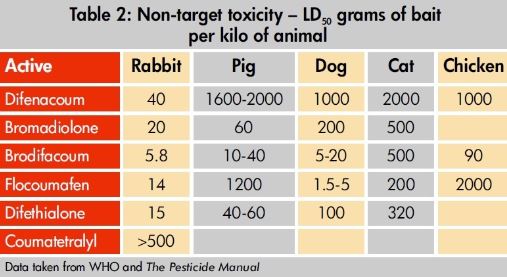Safe & Responsible Use Of Pesticides
The safe and responsible use of rodenticides and other pesticide products is one of the most important aspects of pest control. The incorrect use of rodent baits by both amateurs & professionals is contributing to the increasing levels of resistance to rodenticides by rats and mice as well as the deaths of non-target species such as birds, cats and dogs.
Using rodent baits is not quite as simple as many people believe and when they are used incorrectly the result is often that the rodents will eat the baits but they will not consume a lethal dose and so they begin to build up a level of resistance to that rodenticide. This resistance is passed on to their young and so the problem of resistance compounds as time progresses.
Rodenticide Resistance
Although resistance to the two main rodenticides; Difenacoum and Bromadiolone is now reported on a regular basis across the UK; the claims do need to be treated with caution as they can sometimes be used as an excuse for bad practice and failure to control infestations.
Some pest control companies have taken the decision to abandon the use of both Difenacoum and Bromadiolone and to solely use more potent rodenticides such as Brodifacoum and Flocoumafen.
This can work well from a business point of view as every pest control business wants to be seen as the company that offers the most effective treatments and using these more potent baits usually means that control programs are less susceptible to human errors that may result in control failure.
Brodifacoum and Flocoumafen are also usually laid using a ‘pulse’ baiting method that can be less labour intensive; requiring fewer site visits and also potentially reducing the amount of bait eaten by non-target species. This still however requires the pest controller to understand the technique and to implement it properly.
Whilst it is the case that the use of Brodifacoum and Flocoumafen usually requires the use of a reduced amount of bait; this does not nullify the increased toxicity to non-target species that these rodenticides have (see table below) and the risk posed to wildlife.
(It should be noted that many different factors including the animal’s diet and genetics will affect its susceptibility to these substances and it is not possible to give an exact figure on how much bait needs to be consumed to achieve fatal levels in any specific animal. The figures shown in the table below would give an indication of the average amount of bait that needs to be consumed in order to be fatal)

Image from www.pestmagazine.co.uk
As you can see from the chart above Brodifacoum is believed to be between 50-200 times as toxic to dogs as Difenacoum and between 10-40 times as toxic (to dogs) as Bromadiolone. In comparison indicative research (not displayed) showed that Brodifacoum to be only twice as toxic to house mice as Difenacoum. In practice this would be the difference between a house mouse consuming one or two meals of professional use rodent bait (they eat roughly ten meals a day)
In most cases the increased potency Brodifacoum and Flocoumafen have against rats & mice will not make a noticeable difference to the effectiveness of the treatment and it will not shorten the time that it takes to achieve control as the method by which death occurs (in the rats & mice) are the same regardless of which substance is used.
This does not mean that Brodifacoum or Flocoumafen should not be used in treatments against rats and mice; it just means that they should be used sparingly and only after a proper assessment of the circumstances has been made.
Secondary Poisoning
We must note that poisoning of non-target species does not only occur when non-target species consume rodent bait; it takes place when an animal consumes another animal that has eaten rodent bait. This is known as secondary poisoning and is probably how most poisoning of non-target species occurs.
The reason for this is that the rodenticides used build up in the internal organs in increasing quantities as more is consumed. Death does not occur immediately as the mechanism by which the rodenticides kill takes time to have an effect and is considered to be relatively painless. This time delay is in many ways is an advantage in controlling pests as it prevents ‘bait shyness’ where a rodent will associate a particular bait with feeling unwell and will avoid that food source whilst also potentially alerting other rodents not to eat the bait.
What this means in practice is that by the time the rodents death occurs the level of rodenticide in its body can be high enough to kill an animal or animals many times its own body mass. This means that making regular inspections of the pest treatment area to look for rodent bodies becomes very important in order to minimise this risk.
Bait Stations
The use of suitable bait stations is also essential in outdoor environments and the type used should reflect the surrounding environment in order to minimise any ‘neophobic’ response from rats. Many of the rodent bait boxes sold commercially will give poor results in use as they often look and smell out of place to the rats they are targeted at.
The small size of the bait boxes can also be a problem as rats prefer to feed in groups for safety and to sit up on their hind legs as they are eating. This can be impossible in these small, low boxes and so bait uptake can be dramatically reduced; limiting the effectiveness of the treatment program. This is the main reason that we have our own bait boxes made up to our own specification.
It is also important that the risk of tampering by children or unauthorised adults is taken into account. The use of some type of locking mechanism would usually be employed and securing the bait station to the ground should be considered.
The form of bait used (whether grain, blocks, pasta or pellets) should be decided upon after due consideration is made to the type and scale of infestation and the risk to non-target species.
Non Chemical Control
The use of traps can be effective against small infestations but it is difficult to control large numbers of rodents on their own without the use of rodenticides. Rats in particular are cautious and learn quickly; especially from the mistakes of other rats. Removing the use of rodenticides is desirable and it can be accommodated in some cases but it’s not possible in all circumstances.
All the rodenticides currently available to the pest controller have their place and potent baits such as Brodifacoum are essential to controlling resistant or complex infestations. Whilst saying this it is also the case that legally and morally they must be used with greater caution and not treated as a first resort.on
To get more information and remove pests from your property contact us on 0131 623 1806




